Destinations
Agra
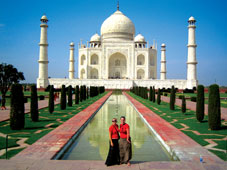 Agra is home to the famous Taj Mahal, one of the Seven Wonders of the World. Its immense amount of history doesn’t end there, though. Agra has two other UNESCO World Heritage Sites: the Agra Fort and Fatehpur Sikri. The grounds of the Taj Mahal and Agra in general are awe-inspiring. There is nothing like this city in the rest of the world, and it has been known to change lives. The history of the Taj Mahal is unlike any other landmark and therefore has garnered much attention over the years. This grand mausoleum was created in memory of Queen Mumtaz Mahal, wife of Emperor Shah Jahan. After she passed away, he dedicated this huge project to her to keep her memory alive. Generations have carried on his wishes: the Taj Mahal and its significant story continues to live on in Agra and in India.
Agra is home to the famous Taj Mahal, one of the Seven Wonders of the World. Its immense amount of history doesn’t end there, though. Agra has two other UNESCO World Heritage Sites: the Agra Fort and Fatehpur Sikri. The grounds of the Taj Mahal and Agra in general are awe-inspiring. There is nothing like this city in the rest of the world, and it has been known to change lives. The history of the Taj Mahal is unlike any other landmark and therefore has garnered much attention over the years. This grand mausoleum was created in memory of Queen Mumtaz Mahal, wife of Emperor Shah Jahan. After she passed away, he dedicated this huge project to her to keep her memory alive. Generations have carried on his wishes: the Taj Mahal and its significant story continues to live on in Agra and in India.
Haridwar
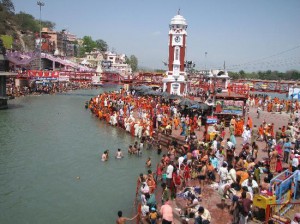 Haridwar is the gateway to the four pilgrimages (Char Dham Yatra) of Uttarakhand (Gangotri, Yamunotri, Badrinath and Kedarnath), and hence an important city. The River Ganges, after flowing for 253 kilometres (157 miles) from its source at Gaumukh at the edge of the Gangotri Glacier, enters the Indo-Gangetic Plains of North India for the first time at Haridwar. It’s also the starting point on the journey to the sacred sources of the rivers Ganga and the Yamuna. The famous Kumbha Mela is celebrated once every 12 years in Haridwar.
Haridwar is the gateway to the four pilgrimages (Char Dham Yatra) of Uttarakhand (Gangotri, Yamunotri, Badrinath and Kedarnath), and hence an important city. The River Ganges, after flowing for 253 kilometres (157 miles) from its source at Gaumukh at the edge of the Gangotri Glacier, enters the Indo-Gangetic Plains of North India for the first time at Haridwar. It’s also the starting point on the journey to the sacred sources of the rivers Ganga and the Yamuna. The famous Kumbha Mela is celebrated once every 12 years in Haridwar.
Varanasi
![]()
![]()
![]()
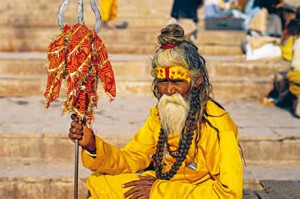 Varanasi is one of the oldest continually inhabited cities in the world, believed to be approximately 3,000 years old. Varanasi is considered to holy by people of various religions, including Buddhists, Jains and Hindus. Varanasi is exceedingly in touch with its inspirational and creative outlets, being home to many established poets, writers, artists, and musicians. Education is another important aspect of Varanasi, and because of the unity of teaching, religion and beauty, Varanasi is often called “the city of learning”, “the holy city of India”, and of course, “the city of lights.”
Varanasi is one of the oldest continually inhabited cities in the world, believed to be approximately 3,000 years old. Varanasi is considered to holy by people of various religions, including Buddhists, Jains and Hindus. Varanasi is exceedingly in touch with its inspirational and creative outlets, being home to many established poets, writers, artists, and musicians. Education is another important aspect of Varanasi, and because of the unity of teaching, religion and beauty, Varanasi is often called “the city of learning”, “the holy city of India”, and of course, “the city of lights.”
Manali - Kullu
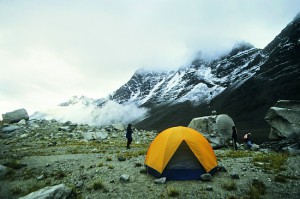 Manali is a picturesque hill station located in Kullu district in the state of Himachal Pradesh. The resplendent natural beauty, lofty Himalayas, colorful orchards, stunning high altitude meadows, rich flora and fauna, colonial charm and pleasant cool climatic conditions make Manali an ideal holiday destination. Manali tours happen along with a trip to Kullu, which is situated forty kilometers away. Kullu is situated at an altitude of 1,200 meters and stands at the confluence of Beas and Sarvari rivers. Kullu valley is most charming and beautiful, spreading its magic on both sides of river Beas. The town is famous for its temples and annual Dusserha festival.
Manali is a picturesque hill station located in Kullu district in the state of Himachal Pradesh. The resplendent natural beauty, lofty Himalayas, colorful orchards, stunning high altitude meadows, rich flora and fauna, colonial charm and pleasant cool climatic conditions make Manali an ideal holiday destination. Manali tours happen along with a trip to Kullu, which is situated forty kilometers away. Kullu is situated at an altitude of 1,200 meters and stands at the confluence of Beas and Sarvari rivers. Kullu valley is most charming and beautiful, spreading its magic on both sides of river Beas. The town is famous for its temples and annual Dusserha festival.
Shimla
 Shimla has been blessed with much natural bounty. It has a scenic location, surrounded by green hills with snow capped peaks. There is a sense of nostalgia about Shimla, with its old bungalows and their gabled roofs and beautiful gardens. The Mall, packed with shops and eateries, is the centre of attraction of the town, and Scandal Point, associated with the former Maharaja of Patiala’s escapades, offers a view of distant snow clad peaks. Shimla is ideally located, and though there is an air service to the town, it is best reached by road that takes in the charms of the Himalayan countryside at its best.
Shimla has been blessed with much natural bounty. It has a scenic location, surrounded by green hills with snow capped peaks. There is a sense of nostalgia about Shimla, with its old bungalows and their gabled roofs and beautiful gardens. The Mall, packed with shops and eateries, is the centre of attraction of the town, and Scandal Point, associated with the former Maharaja of Patiala’s escapades, offers a view of distant snow clad peaks. Shimla is ideally located, and though there is an air service to the town, it is best reached by road that takes in the charms of the Himalayan countryside at its best.
Amritsar
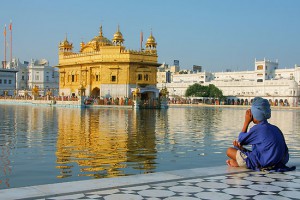 Amritsar, one of the most ancient cities of India, sports some of the most attractive and intriguing tourist locations in the world. Highly regarded when it comes to the Sikh culture, Amritsar offers up close and personal views of their holy practices. Amritsar is named after the rich, pure water that surrounds the Golden Temple itself, and translates to “Holy pool of Nectar.” The pride and joy emitting from this touching, spiritual city is bound to leave an everlasting impact.
Amritsar, one of the most ancient cities of India, sports some of the most attractive and intriguing tourist locations in the world. Highly regarded when it comes to the Sikh culture, Amritsar offers up close and personal views of their holy practices. Amritsar is named after the rich, pure water that surrounds the Golden Temple itself, and translates to “Holy pool of Nectar.” The pride and joy emitting from this touching, spiritual city is bound to leave an everlasting impact.
Delhi
 The spectacular architecture of Delhi, the Indian capital, is evident through in its antique monuments. This city showcases an interesting blend of diverse cultures, having witnessed empires rise to glory and fall to ashes. The contemporary Delhi is a culmination of seven cities built by different emperors. Ruins of this ancient city are found even today and now these are converted to some major tourist attractions. Among some spectacular historic sites, the most prominent ones are: Qutub Minar, Red Fort, Jama Masjid, India Gate, Lotus temple, Humayun tomb and Rashtrapati Bhavan.
The spectacular architecture of Delhi, the Indian capital, is evident through in its antique monuments. This city showcases an interesting blend of diverse cultures, having witnessed empires rise to glory and fall to ashes. The contemporary Delhi is a culmination of seven cities built by different emperors. Ruins of this ancient city are found even today and now these are converted to some major tourist attractions. Among some spectacular historic sites, the most prominent ones are: Qutub Minar, Red Fort, Jama Masjid, India Gate, Lotus temple, Humayun tomb and Rashtrapati Bhavan.
Jaipur
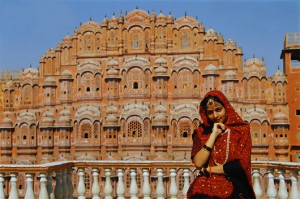 Jaipur was the stronghold of a clan of rulers whose three hill forts and series of palaces in the city are important attractions. Known as the Pink City because of the colour of the stone used exclusively in the walled city, Jaipur is steeped in history and culture. The bustling bazaars of Jaipu, sell embroidered leather shoes, blue pottery, tie and dye scarves and other exotic wares. This fascinating city with its romantic charm takes you to an epoch of royalty and tradition. Jaipur has been laid according to the conventional nine-grid pattern that astrologers believe to be lucky, and which has been recommended in the ancient Indian treatise on architecture.
Jaipur was the stronghold of a clan of rulers whose three hill forts and series of palaces in the city are important attractions. Known as the Pink City because of the colour of the stone used exclusively in the walled city, Jaipur is steeped in history and culture. The bustling bazaars of Jaipu, sell embroidered leather shoes, blue pottery, tie and dye scarves and other exotic wares. This fascinating city with its romantic charm takes you to an epoch of royalty and tradition. Jaipur has been laid according to the conventional nine-grid pattern that astrologers believe to be lucky, and which has been recommended in the ancient Indian treatise on architecture.
Jaisalmer
 This desert fortress is one of Rajasthan’s most exotic and unusual towns. Jaisalmer, an important ancient trading centre because of its strategic location on the camel trade routes, is often described as the ‘golden city’. The havelis, built by merchants of the 19th century, are exquisitely carved from golden-yellow sandstone and are still in a beautiful condition. The fort built by Rawal Jaisal in the 12th century, stands on the 80 metre high Trikuta hill, with beautifully carved Jain temples.
This desert fortress is one of Rajasthan’s most exotic and unusual towns. Jaisalmer, an important ancient trading centre because of its strategic location on the camel trade routes, is often described as the ‘golden city’. The havelis, built by merchants of the 19th century, are exquisitely carved from golden-yellow sandstone and are still in a beautiful condition. The fort built by Rawal Jaisal in the 12th century, stands on the 80 metre high Trikuta hill, with beautifully carved Jain temples.
Ranthambore
 Ranthambore primarily scores its point on the list of tourist attractions because of its tiger reserve. However, the place offers you much more in terms of sightseeing and excursions. Situated on the border of the Thar Desert, Ranthambore is surrounded by the Vindhya Hills and the Aravali Hills. Its very location gives it an advantage of possessing the treasure of mysterious desert lands as well as plain area near the hills. The vegetation primarily comprises of deciduous forests. Ranthambore was the erstwhile hunting grounds of the Maharaja of Jaipur until 1955 when it was declared as a game sanctuary. With the emergence of Project Tiger, it was declared a national park and listed among its protected reserves.
Ranthambore primarily scores its point on the list of tourist attractions because of its tiger reserve. However, the place offers you much more in terms of sightseeing and excursions. Situated on the border of the Thar Desert, Ranthambore is surrounded by the Vindhya Hills and the Aravali Hills. Its very location gives it an advantage of possessing the treasure of mysterious desert lands as well as plain area near the hills. The vegetation primarily comprises of deciduous forests. Ranthambore was the erstwhile hunting grounds of the Maharaja of Jaipur until 1955 when it was declared as a game sanctuary. With the emergence of Project Tiger, it was declared a national park and listed among its protected reserves.
Udaipur
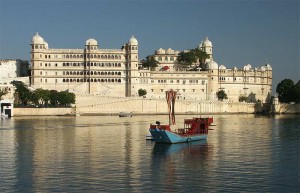 Udaipur has been showered with many sobriquets including ‘Venice of the East’ and ‘City of lakes’. The Lake Palace (Jag Niwas) located in the middle of Pichola Lake is a fine example of architectural and cultural marvel. The grand City Palace on the banks of the lake along with the Monsoon Palace (Sajjan Garh) on the hill above enhances the beauty of this magnificent city. Udaipur is also the centre for performing arts, crafts and its famed miniature paintings. The Shilpgram festival is also a great crowd-puller.
Udaipur has been showered with many sobriquets including ‘Venice of the East’ and ‘City of lakes’. The Lake Palace (Jag Niwas) located in the middle of Pichola Lake is a fine example of architectural and cultural marvel. The grand City Palace on the banks of the lake along with the Monsoon Palace (Sajjan Garh) on the hill above enhances the beauty of this magnificent city. Udaipur is also the centre for performing arts, crafts and its famed miniature paintings. The Shilpgram festival is also a great crowd-puller.
Jodhpur
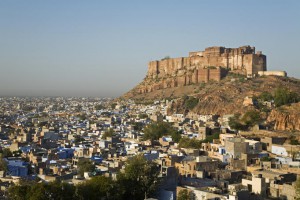 Located on the foothill of a sandstone hillock, the city of Jodhpur seems like an oasis in the vast desert. One of the top tourist destinations in Rajasthan, the glorious past of Jodhpur is personified through the various forts, palaces and other monuments. The main attractions include Mehrangarh Fort situated on a 150m high hill constructed in 1459. Umaid Bhavan Palace is a fascinating palace constructed it in 20th century. A part of the palace has now been converted into a hotel and a museum. Jaswant Thada lies to the left of the Mehrangarh fort complex. It is a royal cenotaph made up of white marble.
Located on the foothill of a sandstone hillock, the city of Jodhpur seems like an oasis in the vast desert. One of the top tourist destinations in Rajasthan, the glorious past of Jodhpur is personified through the various forts, palaces and other monuments. The main attractions include Mehrangarh Fort situated on a 150m high hill constructed in 1459. Umaid Bhavan Palace is a fascinating palace constructed it in 20th century. A part of the palace has now been converted into a hotel and a museum. Jaswant Thada lies to the left of the Mehrangarh fort complex. It is a royal cenotaph made up of white marble.
Khajuraho
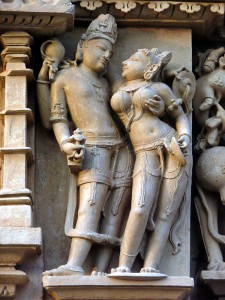 Khajuraho, the temple city of central India, is famous throughout the world for its exquisitely carved temples in stones. Thousands of visitors and tourists from all over the world flock together to envisage this immortal saga of Hindu art and culture engraved in stone by shilpies (stone craftsmen) thousands of years ago. Today Khajuraho is a small village but a thousand years ago it was a large city of the Chandelas, medieval Rajput kings who ruled over Central India.
Khajuraho, the temple city of central India, is famous throughout the world for its exquisitely carved temples in stones. Thousands of visitors and tourists from all over the world flock together to envisage this immortal saga of Hindu art and culture engraved in stone by shilpies (stone craftsmen) thousands of years ago. Today Khajuraho is a small village but a thousand years ago it was a large city of the Chandelas, medieval Rajput kings who ruled over Central India.
Kanha
 Immortalised by Rudyard Kipling in The Jungle Book, the Kanha National Park is among the most spectacular, protected wildlife reserves of the world. The 1,945 sq. km National Park has been compared to N’Gorongoro National Park of Tanzania. The great sal forests of Kanha wildlife sanctuary, stretches across Maikal hills of Satpura range. The grassy plateaux, wooded hills and valleys of Kanha are home to tigers, bears, panther and the rock python. Several great and small mammals, reptiles and birds inhabit the Park including the largest ox in the world – the Gaur. Birdlife of the region is equally astounding and more than 350 avian species have been recorded here with the possibility of sighting yet new races, thus giving the avid birdwatcher great scope for new discoveries.
Immortalised by Rudyard Kipling in The Jungle Book, the Kanha National Park is among the most spectacular, protected wildlife reserves of the world. The 1,945 sq. km National Park has been compared to N’Gorongoro National Park of Tanzania. The great sal forests of Kanha wildlife sanctuary, stretches across Maikal hills of Satpura range. The grassy plateaux, wooded hills and valleys of Kanha are home to tigers, bears, panther and the rock python. Several great and small mammals, reptiles and birds inhabit the Park including the largest ox in the world – the Gaur. Birdlife of the region is equally astounding and more than 350 avian species have been recorded here with the possibility of sighting yet new races, thus giving the avid birdwatcher great scope for new discoveries.
Chhattisgarh
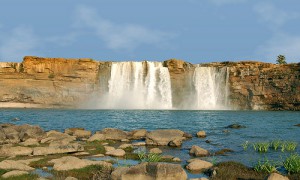 Chhattisgarh, located in the heart of India, is endowed with a unique and rich cultural heritage. The region is full of lush green virgin forests, scenic hills and plateaus intersected by meandering rivers, ancient caves and temples and rich tribal population. Chhattisgarh has been the cradle of several empires and kingdoms, the most prominent being the Mauryas. Hence it has a rich historical and cultural heritage including ancient monuments, palaces, exquisitely carved temples, Buddhist sites, ancient caves and rock paintings. With about 44% of its area under forests, Chhattisgarh is one of the richest bio-diversity regions in the country and one of its emerging eco-tourism destinations.
Chhattisgarh, located in the heart of India, is endowed with a unique and rich cultural heritage. The region is full of lush green virgin forests, scenic hills and plateaus intersected by meandering rivers, ancient caves and temples and rich tribal population. Chhattisgarh has been the cradle of several empires and kingdoms, the most prominent being the Mauryas. Hence it has a rich historical and cultural heritage including ancient monuments, palaces, exquisitely carved temples, Buddhist sites, ancient caves and rock paintings. With about 44% of its area under forests, Chhattisgarh is one of the richest bio-diversity regions in the country and one of its emerging eco-tourism destinations.
Mumbai
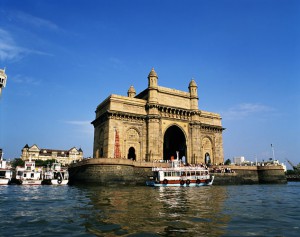 The most modern city in India, Mumbai (formerly Bombay) captures the spirit of the changing pace set by liberalization and modernisation. Once a cluster of seven islands, Mumbai was presented to King Charles II in 1661 as part of the dowry, when he married Princess Catherine de Braganza of Portugal. Over the years, as colonialism gave way to independence, Mumbai transformed itself into an bustling cosmopolitan entity with thriving markets, business houses and many different communities. Must-visit spots include the Gateway of India, Chowpatty Beach and the Elephanta caves.
The most modern city in India, Mumbai (formerly Bombay) captures the spirit of the changing pace set by liberalization and modernisation. Once a cluster of seven islands, Mumbai was presented to King Charles II in 1661 as part of the dowry, when he married Princess Catherine de Braganza of Portugal. Over the years, as colonialism gave way to independence, Mumbai transformed itself into an bustling cosmopolitan entity with thriving markets, business houses and many different communities. Must-visit spots include the Gateway of India, Chowpatty Beach and the Elephanta caves.
Aurangabad
 Named after Mughal Emperor Aurangzeb, Aurangabad is a city in Maharashtra that has many historical monuments of great importance. The monuments of Ajanta and Ellora have been declared as UNESCO World heritage sites. Emperor Aurangzeb’s tomb at Khultabad is also a popular tourist spot. Bibi-ka-Maqbara, which sports a resemblance to the Taj Mahal, is Aurangazeb’s wife’s burial chamber. The city lies on the erstwhile Silk Route, the major trade route connecting India’s sea and land ports to the Deccan area. Aurangabad is famous for its woven Himroo shawls, Mashru and Kimkhab weaves. Bidri, a metal object decorated with Indian art and made of iron, copper and other metals, is also a famous product.
Named after Mughal Emperor Aurangzeb, Aurangabad is a city in Maharashtra that has many historical monuments of great importance. The monuments of Ajanta and Ellora have been declared as UNESCO World heritage sites. Emperor Aurangzeb’s tomb at Khultabad is also a popular tourist spot. Bibi-ka-Maqbara, which sports a resemblance to the Taj Mahal, is Aurangazeb’s wife’s burial chamber. The city lies on the erstwhile Silk Route, the major trade route connecting India’s sea and land ports to the Deccan area. Aurangabad is famous for its woven Himroo shawls, Mashru and Kimkhab weaves. Bidri, a metal object decorated with Indian art and made of iron, copper and other metals, is also a famous product.
Bharatpur
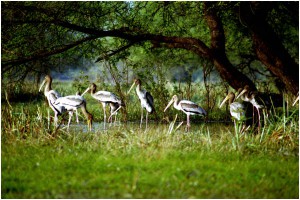 Today, Bharatpur is known the world over for its Keoladeo Ghana National Park. However its history dates back to the epic age, when the Matsya Kingdom flourished here in the 5th century BC. The Matsya were allies of the Pandavas in the Mahabharata war. According to tradition, the name of Bharatpur is traced back to Bharat, brother of lord Rama of the epic Ramayana. Bharatpur is also called the Eastern gateway of Rajasthan. Numerous forts and palaces are found across Bharatpur, including the Pleasure Palace complex at Deeg.
Today, Bharatpur is known the world over for its Keoladeo Ghana National Park. However its history dates back to the epic age, when the Matsya Kingdom flourished here in the 5th century BC. The Matsya were allies of the Pandavas in the Mahabharata war. According to tradition, the name of Bharatpur is traced back to Bharat, brother of lord Rama of the epic Ramayana. Bharatpur is also called the Eastern gateway of Rajasthan. Numerous forts and palaces are found across Bharatpur, including the Pleasure Palace complex at Deeg.
Bangalore
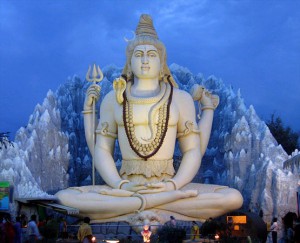 Blessed with a soothing climate, Bangalore is the most preferred tourist destination on south Indian itineraries. Gardens, malls, lakes and ancient bazaars exist side by side here. Famous as the Silicon Valley of India, cultural ethnicity finds a stronghold amid all technological advancements. Famous attractions include Cubbon Park, Wonder La Amusement Park, Innovative Film City (IFC), ISKCON Hare Krishna Temple, Sri Raja Rajeshwari Temple and Lal Bagh.
Blessed with a soothing climate, Bangalore is the most preferred tourist destination on south Indian itineraries. Gardens, malls, lakes and ancient bazaars exist side by side here. Famous as the Silicon Valley of India, cultural ethnicity finds a stronghold amid all technological advancements. Famous attractions include Cubbon Park, Wonder La Amusement Park, Innovative Film City (IFC), ISKCON Hare Krishna Temple, Sri Raja Rajeshwari Temple and Lal Bagh.
Ooty
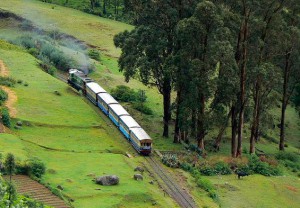 Known as the Queen of Hill Stations, Ooty used to be the favoured getaway for the British during colonial times. Besides its beautiful mountains and rich vegetation, Ooty will take your breath away with its grasslands and tea estates. Travel on the mountain train, an added attraction for tourists.
Known as the Queen of Hill Stations, Ooty used to be the favoured getaway for the British during colonial times. Besides its beautiful mountains and rich vegetation, Ooty will take your breath away with its grasslands and tea estates. Travel on the mountain train, an added attraction for tourists.
Alleppy
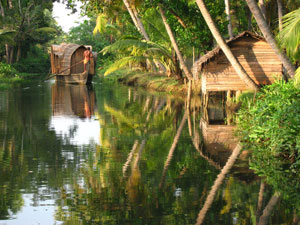 Alleppey is known as Venice of the east due of its large network of inland canals. In the past, it was one of the busiest trade centers. Today, it is renowned for its famed backwaters and also the annual snake boat race competition held every year on second Saturday of August. Over the years, Alleppey has remained relatively unchanged and this makes the destination quite special.
Alleppey is known as Venice of the east due of its large network of inland canals. In the past, it was one of the busiest trade centers. Today, it is renowned for its famed backwaters and also the annual snake boat race competition held every year on second Saturday of August. Over the years, Alleppey has remained relatively unchanged and this makes the destination quite special.
Cochin
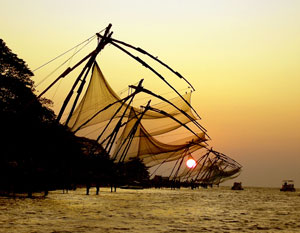 The commercial capital of Kerala, Cochin is a cosmopolitan city with an outstanding port and international airport linking it to major cities across the world. Flanked by Western Ghats and Arabian Sea, this gorgeous sea side city is a popular tourist destination. Here one can enjoy boat rides and Kathakali dance performances. Top tourist spots in Cochin are Chinese Fishing Nets, Fort Kochi beach, Jewish Synagogue and Jew Town, Dutch Palace, Hill Palace and many more.
The commercial capital of Kerala, Cochin is a cosmopolitan city with an outstanding port and international airport linking it to major cities across the world. Flanked by Western Ghats and Arabian Sea, this gorgeous sea side city is a popular tourist destination. Here one can enjoy boat rides and Kathakali dance performances. Top tourist spots in Cochin are Chinese Fishing Nets, Fort Kochi beach, Jewish Synagogue and Jew Town, Dutch Palace, Hill Palace and many more.
Chennai
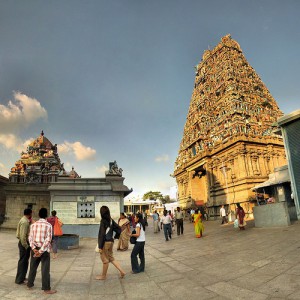 Chennai, the capital of Tamil Nadu, is famous as the ‘Gateway to South India‘. Chennai has been endowed with rich heritage of art and culture. Various cultural events, showcasing the performing arts such as dance, music and drama, are held regularly in the city. As a travel destination, it offers variety of options: George Town, Government Museum, National Art Gallery, Marina Beach, Santhome Cathedral and Snake Park are the most popular highlights.
Chennai, the capital of Tamil Nadu, is famous as the ‘Gateway to South India‘. Chennai has been endowed with rich heritage of art and culture. Various cultural events, showcasing the performing arts such as dance, music and drama, are held regularly in the city. As a travel destination, it offers variety of options: George Town, Government Museum, National Art Gallery, Marina Beach, Santhome Cathedral and Snake Park are the most popular highlights.
Madurai
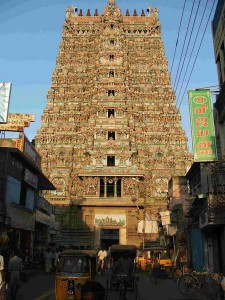 Madurai, one of South India’s great temple towns, is famous worldwide for the much celebrated Meenakshi Temple. Located on the banks of Vaigai River, this place dates back 2,500 years from the great Tamil era. Since time immemorial, Madurai has been a significant cultural and commercial center. During the supremacy of great Pandya Kings, Madurai enjoyed the status of the capital city. Apart from the temple, other highlights include the Thirumala Naicker palace.
Madurai, one of South India’s great temple towns, is famous worldwide for the much celebrated Meenakshi Temple. Located on the banks of Vaigai River, this place dates back 2,500 years from the great Tamil era. Since time immemorial, Madurai has been a significant cultural and commercial center. During the supremacy of great Pandya Kings, Madurai enjoyed the status of the capital city. Apart from the temple, other highlights include the Thirumala Naicker palace.
Kanchipuram
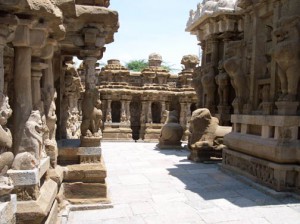 The City of Thousand Temples, Kanchipuram is one of the oldest temple towns of India. Revered as one of India’s seven holy cities, Kanchipuram was ruled by several powerful dynasties like Cholas, Pallavas and the empire of Vijayanagar. Each one of them imparted a unique architectural style to the temples and monuments. The famous hand-woven silk fabrics and saris of Kanchipuram are woven by skilled weavers who use the supreme quality silk and pure gold thread. With great availability of varied quality of silk, Kanchipuram is also known as Silk City. Highly venerated Sankaracharya ‘Math’ is located at Kanchipuram.
The City of Thousand Temples, Kanchipuram is one of the oldest temple towns of India. Revered as one of India’s seven holy cities, Kanchipuram was ruled by several powerful dynasties like Cholas, Pallavas and the empire of Vijayanagar. Each one of them imparted a unique architectural style to the temples and monuments. The famous hand-woven silk fabrics and saris of Kanchipuram are woven by skilled weavers who use the supreme quality silk and pure gold thread. With great availability of varied quality of silk, Kanchipuram is also known as Silk City. Highly venerated Sankaracharya ‘Math’ is located at Kanchipuram.
Mahabalipuram
 Globally renowned for its shore temples, Mahabalipuram was the capital of the Pallava kings of Kanchipuram. 58 km from Chennai on the Bay of Bengal, this small coastal village is set in a boulder – strewn landscape. Miles of unspoiled beach and exquisite rock-cut art ensures its popularity among tourists. The sculptures depict of day-to- day life, in contrast with the rest of Tamil Nadu, where carvings generally depict gods and goddesses.
Globally renowned for its shore temples, Mahabalipuram was the capital of the Pallava kings of Kanchipuram. 58 km from Chennai on the Bay of Bengal, this small coastal village is set in a boulder – strewn landscape. Miles of unspoiled beach and exquisite rock-cut art ensures its popularity among tourists. The sculptures depict of day-to- day life, in contrast with the rest of Tamil Nadu, where carvings generally depict gods and goddesses.
Mysore
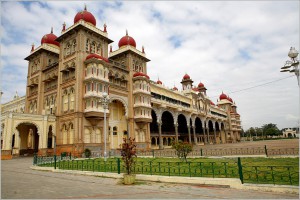 Known for its magnificent Sandalwood products, Mysore reflects the rich culture of Karnataka. Mysore conjures up visions of the glory of the Wodeyar Kings. This former state capital retains its tradition in music, dance, art and literature. Popular spots include Ambavilas Palace (Mysore Palace), Lalitha Mahal Palace, Jayalakshmi Vilas, Chamundeshwari Temple (Chamundi Hills), Mysore Zoo, Regional Museum of Natural History, Brindavan Gardens, Railway Museum and Nagarhole National Park.
Known for its magnificent Sandalwood products, Mysore reflects the rich culture of Karnataka. Mysore conjures up visions of the glory of the Wodeyar Kings. This former state capital retains its tradition in music, dance, art and literature. Popular spots include Ambavilas Palace (Mysore Palace), Lalitha Mahal Palace, Jayalakshmi Vilas, Chamundeshwari Temple (Chamundi Hills), Mysore Zoo, Regional Museum of Natural History, Brindavan Gardens, Railway Museum and Nagarhole National Park.
Pondicherry
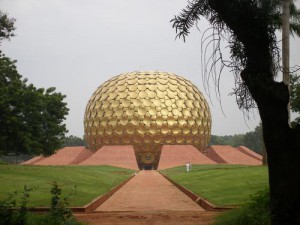 With grand boulevards and quiet promenades Pondicherry town is a quite a surprise. The four unconnected, erstwhile French colonies of Pondicherry, Karaikal, Mahe and Yanam together form the Union Territory of Pondicherry. Opulently cosmopolitan, Pondicherry is a preferred hunting ground for the shop-hopper as wonderful bargains are easily available. Famous places to visit: the old colonial quarter, Pondicherry Museum, Sri Aurobindo Ashram, Old Light House, Immaculate Conception of Mother Mary Cathedral, Botanical Garden and certainly Auroville.
With grand boulevards and quiet promenades Pondicherry town is a quite a surprise. The four unconnected, erstwhile French colonies of Pondicherry, Karaikal, Mahe and Yanam together form the Union Territory of Pondicherry. Opulently cosmopolitan, Pondicherry is a preferred hunting ground for the shop-hopper as wonderful bargains are easily available. Famous places to visit: the old colonial quarter, Pondicherry Museum, Sri Aurobindo Ashram, Old Light House, Immaculate Conception of Mother Mary Cathedral, Botanical Garden and certainly Auroville.
Munnar
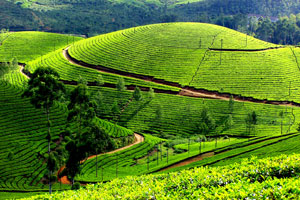 One of the most popular hill stations in India, Munnar is situated at the confluence of three mountain streams. Summer resort of the erstwhile British Government in South India, Munnar has sprawling tea plantations, picture book towns, winding lanes, trekking and holiday facilities. Munnar is essentially a tea town and the visitor is greeted with miles and miles of unending tea plantations. Among the exotic flora found in the forests and grasslands here is the Neelakurinji, a flower which bathes the hills in blue colour once in twelve years. Munnar also has the highest peak in South India – Anamudi, an ideal spot for trekkers.
One of the most popular hill stations in India, Munnar is situated at the confluence of three mountain streams. Summer resort of the erstwhile British Government in South India, Munnar has sprawling tea plantations, picture book towns, winding lanes, trekking and holiday facilities. Munnar is essentially a tea town and the visitor is greeted with miles and miles of unending tea plantations. Among the exotic flora found in the forests and grasslands here is the Neelakurinji, a flower which bathes the hills in blue colour once in twelve years. Munnar also has the highest peak in South India – Anamudi, an ideal spot for trekkers.
Thekkady
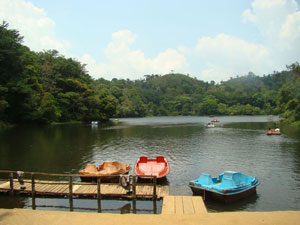 Thekkady is one of India’s most fascinating natural wildlife sanctuaries, where you can watch wildlife at close range. The Periyar forest of Thekkady is one of the finest wildlife reserves in India, and spread across the entire district are picturesque plantations and hill towns that hold great opportunities for treks and mountain walks. The Thekkady sanctuary is one of the best in the country for watching and photographing wild life. Notable among the denizens of Periyar are the tigers, the majestic Asiatic wild elephants and the distinctive Nilgiri langur. Other animals include the wild boar, wild dog, bison, bear and leopards. Amongst the avifauna, the most profuse are herons, egrets, darters, kingfishers and the great Malabar grey hornbill. A cruise through the waters of Periyar lake around which the wild -life sanctuary is situated, offers a pleasant experience.
Thekkady is one of India’s most fascinating natural wildlife sanctuaries, where you can watch wildlife at close range. The Periyar forest of Thekkady is one of the finest wildlife reserves in India, and spread across the entire district are picturesque plantations and hill towns that hold great opportunities for treks and mountain walks. The Thekkady sanctuary is one of the best in the country for watching and photographing wild life. Notable among the denizens of Periyar are the tigers, the majestic Asiatic wild elephants and the distinctive Nilgiri langur. Other animals include the wild boar, wild dog, bison, bear and leopards. Amongst the avifauna, the most profuse are herons, egrets, darters, kingfishers and the great Malabar grey hornbill. A cruise through the waters of Periyar lake around which the wild -life sanctuary is situated, offers a pleasant experience.
Hyderabad
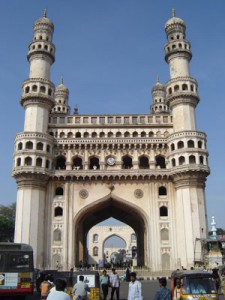 Endearingly called the Pearl City, Hyderabad offers a variety of tourist attractions ranging from heritage monuments, lakes and parks, gardens and museums to delectable cuisine and a delightful shopping experience. To the traveller, Hyderabad offers a fascinating panorama of the past, with a richly mixed cultural and historical tradition spanning 400 colourful years. Some of the tourist attractions include The Charminar, Mecca Masjid, Laad Baazar, Golconda Fort and Qutb Shahi Tombs. Not to be missed is the Light and Sound Show at the Golconda Fort. A more recent attraction is the Ramoji Film City.
Endearingly called the Pearl City, Hyderabad offers a variety of tourist attractions ranging from heritage monuments, lakes and parks, gardens and museums to delectable cuisine and a delightful shopping experience. To the traveller, Hyderabad offers a fascinating panorama of the past, with a richly mixed cultural and historical tradition spanning 400 colourful years. Some of the tourist attractions include The Charminar, Mecca Masjid, Laad Baazar, Golconda Fort and Qutb Shahi Tombs. Not to be missed is the Light and Sound Show at the Golconda Fort. A more recent attraction is the Ramoji Film City.
Coimbatore
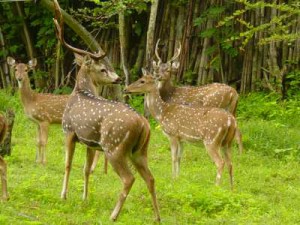 Coimbatore, one of the most industrialized cities in Tamil Nadu, is also known as the Manchester of the South. The city is situated on the banks of the river Noyyal, and dates back to the 3rd century AD. Its great rulers include the Cholas, Rashtrakutas, Chalukyas, Pandyas, Hoysalas and the Vijayanagara kings. Earlier known as Kongunadu, its name was changed to Coimbatore when it fell to the British. Coimbatore serves as an entry and exit point to neighbouring Kerala and the ever popular hill station of Udhagamandalam (Ooty). It is the disembarking point for those who want to take the Mountain train that runs from Mettupalayam, 35 kms from Coimbatore.
Coimbatore, one of the most industrialized cities in Tamil Nadu, is also known as the Manchester of the South. The city is situated on the banks of the river Noyyal, and dates back to the 3rd century AD. Its great rulers include the Cholas, Rashtrakutas, Chalukyas, Pandyas, Hoysalas and the Vijayanagara kings. Earlier known as Kongunadu, its name was changed to Coimbatore when it fell to the British. Coimbatore serves as an entry and exit point to neighbouring Kerala and the ever popular hill station of Udhagamandalam (Ooty). It is the disembarking point for those who want to take the Mountain train that runs from Mettupalayam, 35 kms from Coimbatore.
Thiruvananthapuram (Trivandrum)
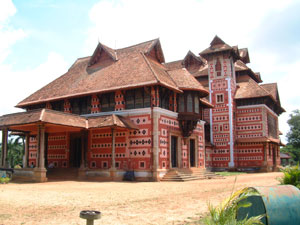 Thiruvananthapuram, the capital of Kerala, is a city where the beautiful shadows of the past coexist with the present. Thiruvananthapuram, literally translates into the “abode of Lord Anantha” and the Sri PadmanabhaswamyTemple, in the heart of the city is devoted to the deity Anantha. The city being the capital is the center spot for the political activities of the State. Tourist attractions include the Napier Museum, Zoo, Kuthiramalika (Horse palace) and Shangumugham Beach. An hour’s drive away is the world-famous Kovalam Beach, a veritable magnet for tourists.
Thiruvananthapuram, the capital of Kerala, is a city where the beautiful shadows of the past coexist with the present. Thiruvananthapuram, literally translates into the “abode of Lord Anantha” and the Sri PadmanabhaswamyTemple, in the heart of the city is devoted to the deity Anantha. The city being the capital is the center spot for the political activities of the State. Tourist attractions include the Napier Museum, Zoo, Kuthiramalika (Horse palace) and Shangumugham Beach. An hour’s drive away is the world-famous Kovalam Beach, a veritable magnet for tourists.
Goa
 Think Goa and spectacular sandy beaches come to mind. Indeed its scenic beauty, architectural splendors and old world charm have made Goa a firm favorite with travelers around the world. Travellers to Goa also love the laid-back, peaceful, warm and friendly nature of the Goan people. This is a place where people have mastered the art of relaxation. But, Goa is much more than just beaches and the sea. Much of the real Goa is in its interiors, both inside its buildings and in the hinterland away from the coastal area.
Think Goa and spectacular sandy beaches come to mind. Indeed its scenic beauty, architectural splendors and old world charm have made Goa a firm favorite with travelers around the world. Travellers to Goa also love the laid-back, peaceful, warm and friendly nature of the Goan people. This is a place where people have mastered the art of relaxation. But, Goa is much more than just beaches and the sea. Much of the real Goa is in its interiors, both inside its buildings and in the hinterland away from the coastal area.



.png)

